2014 MERCEDES-BENZ C-CLASS ESTATE warning
[x] Cancel search: warningPage 111 of 489

key. This function remains active for five
minutes or until you open a front door.
The side windows cannot be operated from
the rear when the override feature for the side
windows is activated (Y page 75).
i Information on opening and closing the
roller sunblinds on the rear side windows
(Y page 383). Convenience opening feature
General notes Vehicles with KEYLESS-GO or KEYLESS-
GO start function:
you can ventilate the vehi-
cle before you start driving.
If the key is in the immediate vicinity to the
vehicle, the convenience opening function is
available.
To do this, the key is used to carry out the
following functions simultaneously:
R unlock the vehicle
R open the side windows
R open the sliding sunroof or the panorama
sliding sunroof and the roller sunblind
R switch on the seat ventilation for the driv-
er's seat
Convenience opening feature X
Press and hold the %button until the
side windows and the sliding sunroof or the panorama sliding sunroof are in the desired
position.
If the roller sunblinds of the panorama slid- ing sunroof are closed, the roller sunblinds
are opened first.
X Press and hold the %button again until
the panorama sliding sunroof is in the
desired position.
X To interrupt convenience opening:
release the %button. Convenience closing feature
Important safety notes G
WARNING
When the convenience closing feature is oper- ating, parts of the body could become trapped
in the closing area of the side window and the
sliding sunroof. There is a risk of injury.
Observe the complete closing procedure
when the convenience closing feature is oper-
ating. When closing make sure that no parts of the body are in the closing area.
Vehicles with KEYLESS-GO or KEYLESS-
GO start function: if the key is in the imme-
diate vicinity to the vehicle, the convenience
closing function is available.
When you lock the vehicle, you can simulta-
neously:
R close the side windows
R close the sliding sunroof or the panorama
sliding sunroof
On vehicles with a panorama sliding sunroof, you can then close the roller sunblinds.
Notes on the automatic reversing feature for:
R the side windows (Y page 107)
R the sliding sunroof or the panorama sliding
sunroof (Y page 111)
Using the key X
Press and hold the &button until the
side windows and the sliding sunroof or the
panorama sliding sunroof are fully closed.
X Make sure that all the side windows and the
sliding sunroof or panorama sliding sunroof are closed.
X Vehicles with panorama sliding sun-
roof: press and hold the &button until
the roller sunblinds of the panorama sliding
sunroof close.
X To interrupt convenience closing:
release the &button. 108
Side
windowsOpening an d closing
Page 113 of 489

Problems with the side windows
G
WARNING
If you close a side window again immediately after it has been blocked or reset, the side window
closes with increased or maximum force. The reversing function is then not active. Parts of the
body could be trapped in the closing area in the process. This poses an increased risk of injury or even fatal injury.
Make sure that no parts of the body are in the closing area. To stop the closing process, releasethe switch or push the switch again to reopen the side window. Problem
Possible causes/consequences and
M MSolutions A side window cannot
be closed because it is
blocked by objects, e.g.
leaves in the window
guide. X
Remove the objects.
X Close the side window. A side window cannot
be closed and you can-
not see the cause. If a side window is obstructed during closing and reopens again
slightly:
X Immediately after the window blocks, pull the corresponding
switch again until the side window has closed.
The side window is closed with increased force.
If a side window is obstructed again during closing and reopens
again slightly: X Immediately after the window blocks, pull the corresponding
switch again until the side window has closed.
The side window is closed without the anti-entrapment feature. Sliding sunroof
Important safety notes
Your vehicle may be fitted with a sliding sun-
roof or a panorama sliding sunroof. In this
section, the term "sliding sunroof" refers to
both types of sliding sunroof. G
WARNING
While opening and closing the sliding sunroof, body parts in close proximity could become
trapped. There is a risk of injury.
Make sure that no body parts are in close
proximity during the opening and closing pro- cedures. If somebody becomes trapped:
R release the switch immediately, or
R during automatic operation, press the
switch briefly in any direction
The opening or closing procedure will be stop-
ped. G
WARNING
If children operate the sliding sunroof they
could become trapped, particularly if they are left unsupervised. There is a risk of injury.
When leaving the vehicle, always take the key
with you and lock the vehicle. Never leave
children unattended in the vehicle. 110
Sliding sunroofOpening and closing
Page 114 of 489
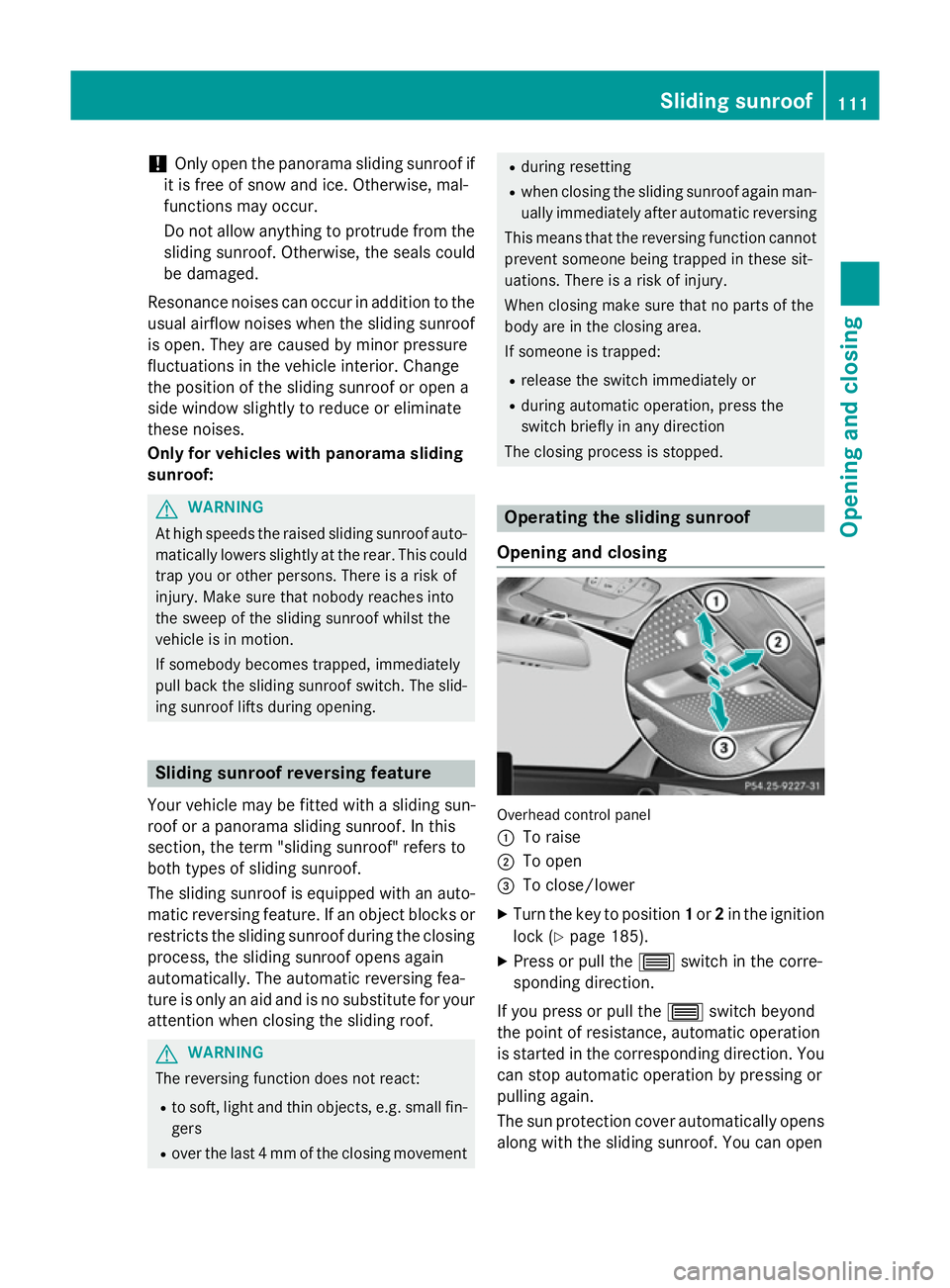
!
Only open the panorama sliding sunroof if
it is free of snow and ice. Otherwise, mal-
functions may occur.
Do not allow anything to protrude from the sliding sunroof. Otherwise, the seals could
be damaged.
Resonance noises can occur in addition to the
usual airflow noises when the sliding sunroof is open. They are caused by minor pressure
fluctuations in the vehicle interior. Change
the position of the sliding sunroof or open a
side window slightly to reduce or eliminate
these noises.
Only for vehicles with panorama sliding
sunroof: G
WARNING
At high speeds the raised sliding sunroof auto- matically lowers slightly at the rear. This could
trap you or other persons. There is a risk of
injury. Make sure that nobody reaches into
the sweep of the sliding sunroof whilst the
vehicle is in motion.
If somebody becomes trapped, immediately
pull back the sliding sunroof switch. The slid- ing sunroof lifts during opening. Sliding sunroof reversing feature
Your vehicle may be fitted with a sliding sun-
roof or a panorama sliding sunroof. In this
section, the term "sliding sunroof" refers to
both types of sliding sunroof.
The sliding sunroof is equipped with an auto- matic reversing feature. If an object blocks or
restricts the sliding sunroof during the closing process, the sliding sunroof opens again
automatically. The automatic reversing fea-
ture is only an aid and is no substitute for your
attention when closing the sliding roof. G
WARNING
The reversing function does not react:
R to soft, light and thin objects, e.g. small fin-
gers
R over the last 4 mm of the closing movement R
during resetting
R when closing the sliding sunroof again man-
ually immediately after automatic reversing
This means that the reversing function cannot prevent someone being trapped in these sit-
uations. There is a risk of injury.
When closing make sure that no parts of the
body are in the closing area.
If someone is trapped:
R release the switch immediately or
R during automatic operation, press the
switch briefly in any direction
The closing process is stopped. Operating the sliding sunroof
Opening and closing Overhead control panel
:
To raise
; To open
= To close/lower
X Turn the key to position 1or 2in the ignition
lock (Y page 185).
X Press or pull the 3switch in the corre-
sponding direction.
If you press or pull the 3switch beyond
the point of resistance, automatic operation
is started in the corresponding direction. You can stop automatic operation by pressing or
pulling again.
The sun protection cover automatically opens
along with the sliding sunroof. You can open Sliding sunroof
111Opening and closing Z
Page 116 of 489

active for five minutes or until you open a
front door.
The panorama sliding sunroof cannot be
opened if a roof carrier is fitted. In order to
allow ventilation of the vehicle interior, you
can raise the panorama sliding sunroof. If a
roof carrier approved by Mercedes-Benz
makes contact with the panorama sliding
sunroof, the sunroof will lower slightly but
remain raised at the rear.
Rain-closing feature when the engine is
switched off If the key is in position
0in the ignition lock or
if it is removed, the panorama sliding sunroof
closes automatically:
R if it starts to rain.
R at extreme outside temperatures.
R after six hours.
R if there is a malfunction in the power sup-
ply.
The panorama sliding sunroof remains raised
at the rear in order to allow ventilation of the vehicle interior.
If the panorama sliding sunroof is obstructed
when being closed by the rain-closing feature,
it opens again slightly. The rain-closing fea-
ture is then deactivated.
The panorama sliding sunroof does not close if:
R it is raised at the rear.
R it is blocked.
R no rain is falling on the area of the wind-
screen being monitored by the rain sensor. If the vehicle, for example, is under a bridge
or in a carport, the field of the sensor may
be covered.
Rain-closing feature when driving The raised sliding sunroof automatically low-
ers at the rear when driving if it starts to rain.
The sliding sunroof is lowered depending on:
R the road speed and
R the intensity of the rain You can manually cancel the automatic clos-
ing procedure. Press or pull the
3switch
in any direction.
To raise the sliding sunroof again, press the
3 switch in direction :.
The "Rain-closing feature when driving" func-
tion is deactivated, until you:
R press or pull the 3switch in any direc-
tion or
R turn the key to another position in the igni-
tion lock (Y page 185). Operating the panorama sliding sun-
roof roller sunblinds
Important safety notes G
WARNING
When opening or closing the roller sunblind
parts of the body could be trapped between
the roller sunblind and the frame or sliding
sunroof. There is a risk of injury.
When opening or closing make sure that no
parts of the body are in the sweep of the roller sunblind.
If someone is trapped:
R release the switch immediately or
R during automatic operation, press the
switch briefly in any direction
The opening/closing process is stopped.
The roller sunblinds shield the vehicle interior from sunlight. The front roller sunblind can
only be opened and closed when the sliding
sunroof is closed.
Roller sunblinds reversing feature The roller sunblinds are equipped with an
automatic reversing feature. If a solid object
blocks or restricts the roller blind during the
closing process, the roller blind opens again
automatically. However, the automatic
reversing feature is only an aid, not a substi-
tute for your attention when closing the roller
sunblind. Sliding sunroof
113Opening and closing Z
Page 117 of 489
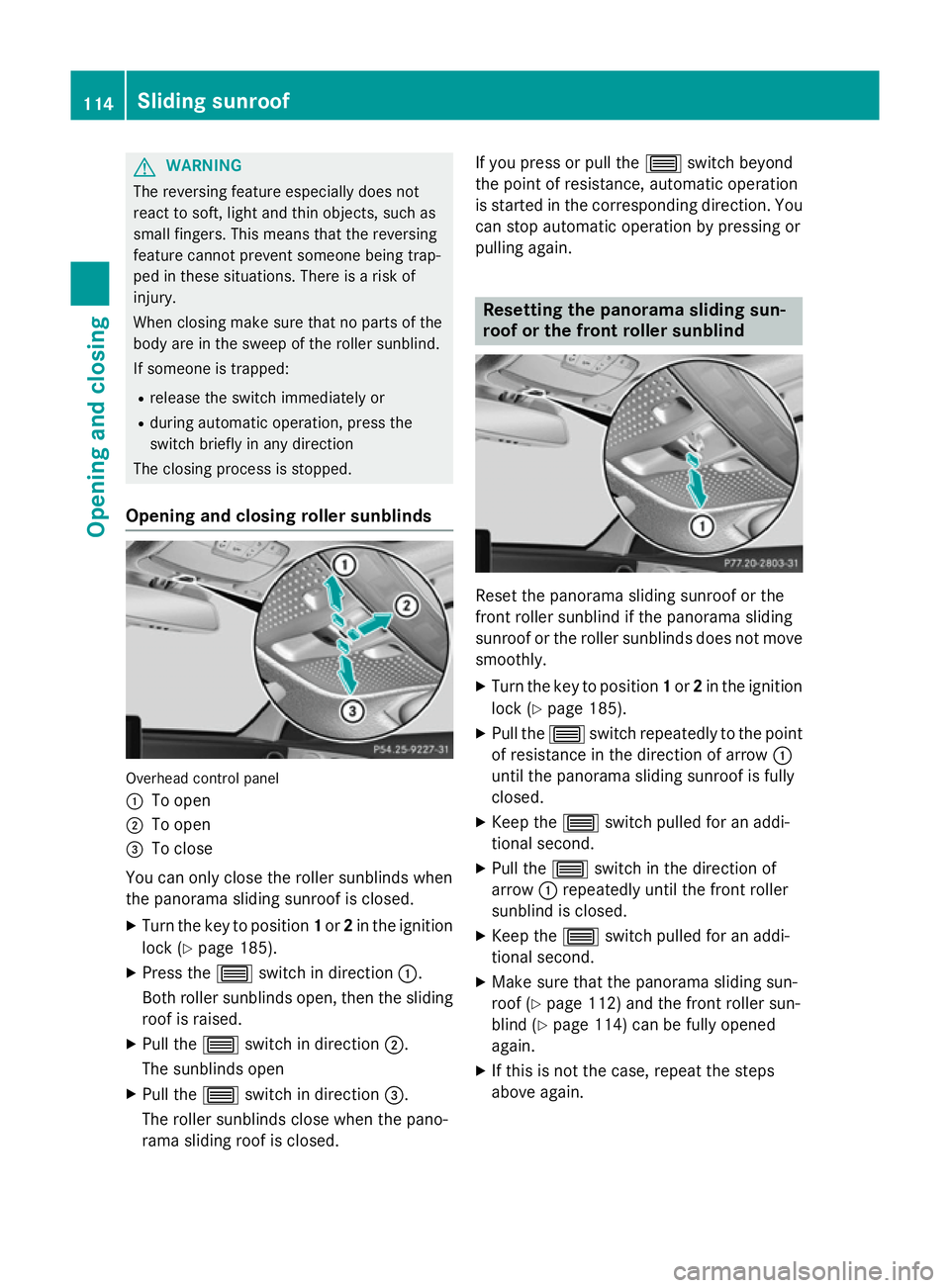
G
WARNING
The reversing feature especially does not
react to soft, light and thin objects, such as
small fingers. This means that the reversing
feature cannot prevent someone being trap-
ped in these situations. There is a risk of
injury.
When closing make sure that no parts of the
body are in the sweep of the roller sunblind.
If someone is trapped:
R release the switch immediately or
R during automatic operation, press the
switch briefly in any direction
The closing process is stopped.
Opening and closing roller sunblinds Overhead control panel
:
To open
; To open
= To close
You can only close the roller sunblinds when
the panorama sliding sunroof is closed.
X Turn the key to position 1or 2in the ignition
lock (Y page 185).
X Press the 3switch in direction :.
Both roller sunblinds open, then the sliding
roof is raised.
X Pull the 3switch in direction ;.
The sunblinds open
X Pull the 3switch in direction =.
The roller sunblinds close when the pano-
rama sliding roof is closed. If you press or pull the
3switch beyond
the point of resistance, automatic operation
is started in the corresponding direction. You
can stop automatic operation by pressing or
pulling again. Resetting the panorama sliding sun-
roof or the front roller sunblind
Reset the panorama sliding sunroof or the
front roller sunblind if the panorama sliding
sunroof or the roller sunblinds does not move smoothly.
X Turn the key to position 1or 2in the ignition
lock (Y page 185).
X Pull the 3switch repeatedly to the point
of resistance in the direction of arrow :
until the panorama sliding sunroof is fully
closed.
X Keep the 3switch pulled for an addi-
tional second.
X Pull the 3switch in the direction of
arrow :repeatedly until the front roller
sunblind is closed.
X Keep the 3switch pulled for an addi-
tional second.
X Make sure that the panorama sliding sun-
roof (Y page 112) and the front roller sun-
blind (Y page 114) can be fully opened
again.
X If this is not the case, repeat the steps
above again. 114
Sliding sunroofOpening and closing
Page 118 of 489
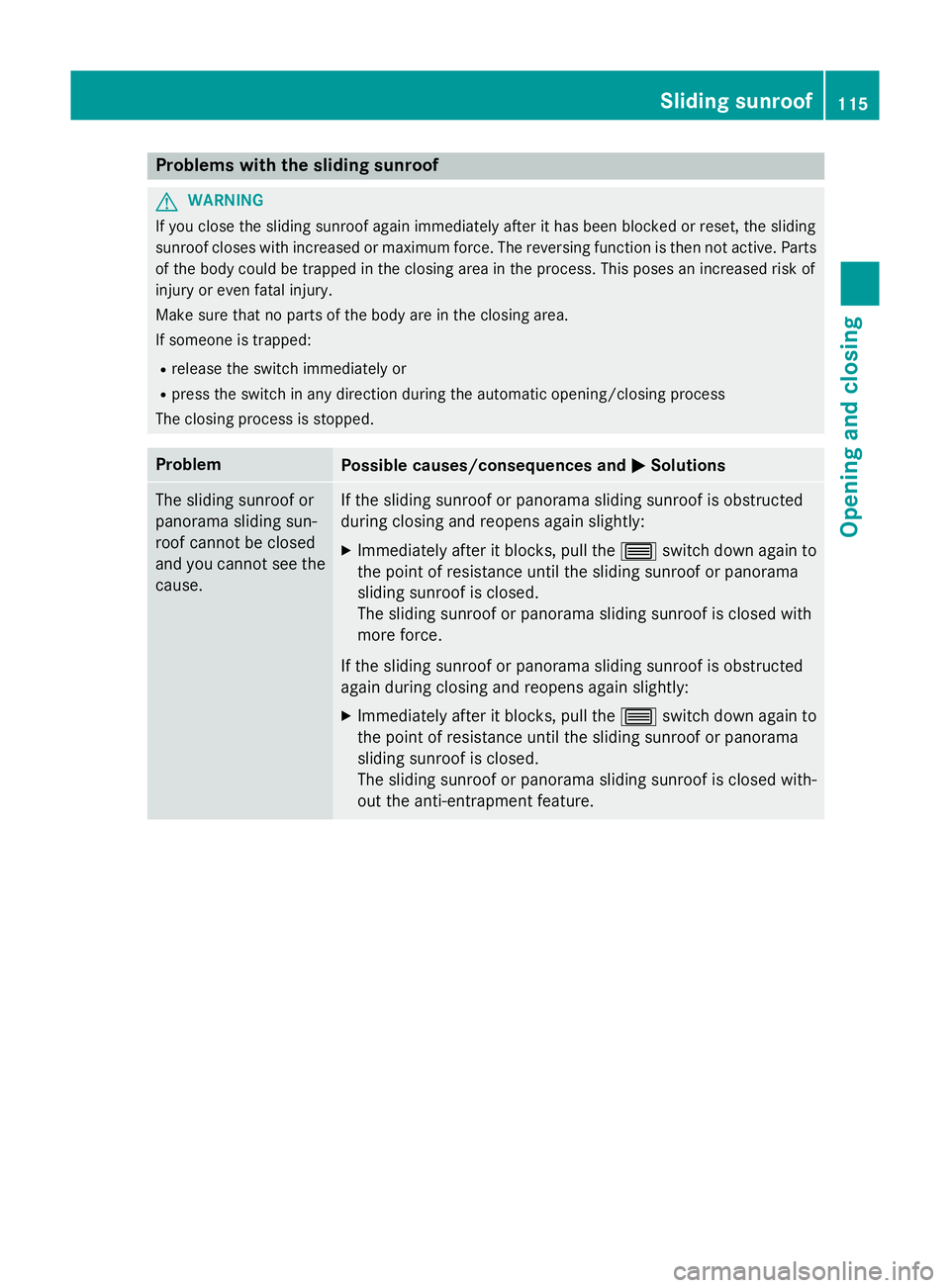
Problems with the sliding sunroof
G
WARNING
If you close the sliding sunroof again immediately after it has been blocked or reset, the sliding
sunroof closes with increased or maximum force. The reversing function is then not active. Parts of the body could be trapped in the closing area in the process. This poses an increased risk of
injury or even fatal injury.
Make sure that no parts of the body are in the closing area.
If someone is trapped:
R release the switch immediately or
R press the switch in any direction during the automatic opening/closing process
The closing process is stopped. Problem
Possible causes/consequences and
M MSolutions The sliding sunroof or
panorama sliding sun-
roof cannot be closed
and you cannot see the
cause. If the sliding sunroof or panorama sliding sunroof is obstructed
during closing and reopens again slightly:
X Immediately after it blocks, pull the 3switch down again to
the point of resistance until the sliding sunroof or panorama
sliding sunroof is closed.
The sliding sunroof or panorama sliding sunroof is closed with
more force.
If the sliding sunroof or panorama sliding sunroof is obstructed
again during closing and reopens again slightly:
X Immediately after it blocks, pull the 3switch down again to
the point of resistance until the sliding sunroof or panorama
sliding sunroof is closed.
The sliding sunroof or panorama sliding sunroof is closed with-
out the anti-entrapment feature. Sliding sunroof
115Opening and closing Z
Page 121 of 489
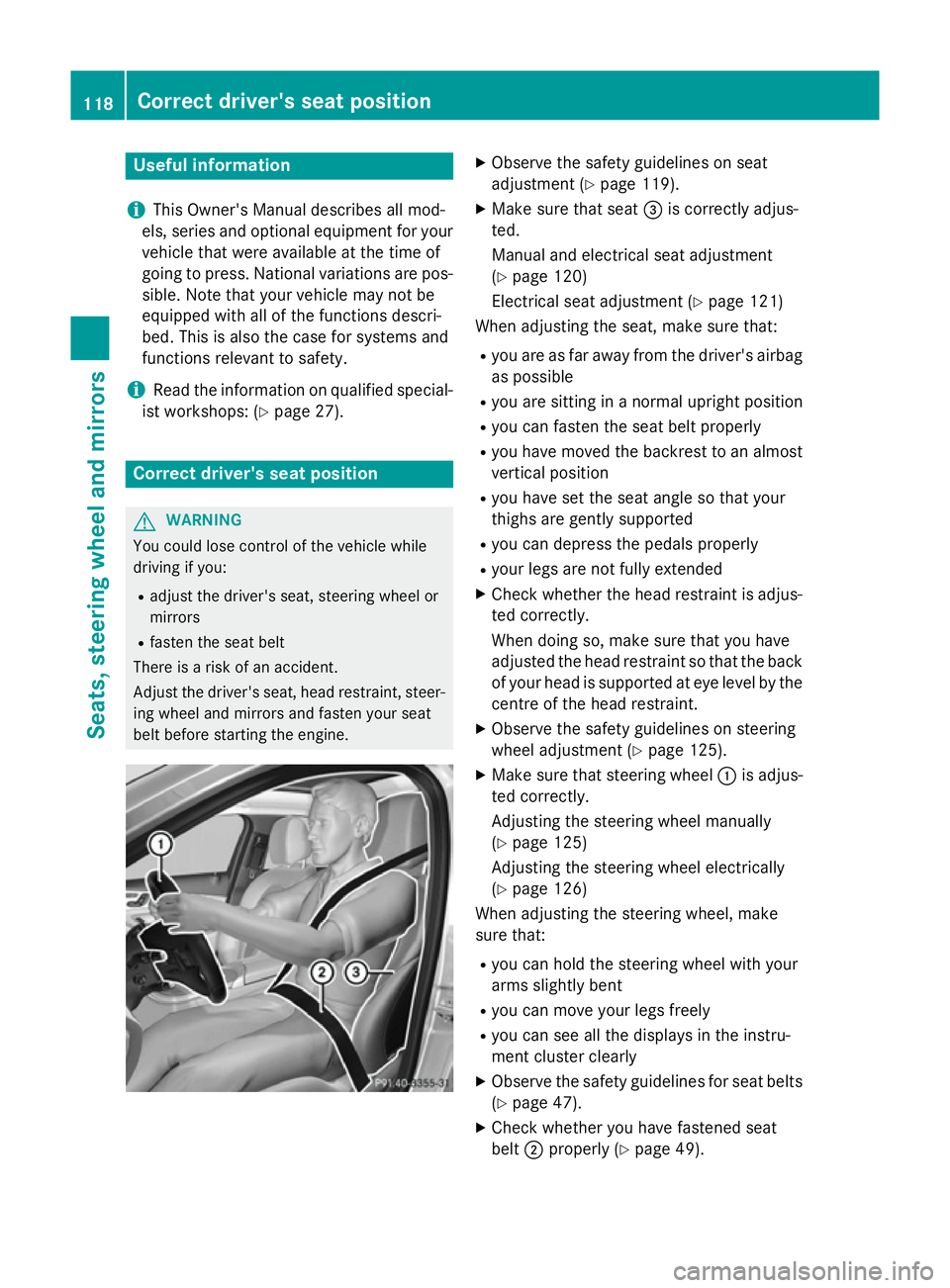
Useful information
i This Owner's Manual describes all mod-
els, series and optional equipment for your
vehicle that were available at the time of
going to press. National variations are pos- sible. Note that your vehicle may not be
equipped with all of the functions descri-
bed. This is also the case for systems and
functions relevant to safety.
i Read the information on qualified special-
ist workshops: (Y page 27). Correct driver's seat position
G
WARNING
You could lose control of the vehicle while
driving if you:
R adjust the driver's seat, steering wheel or
mirrors
R fasten the seat belt
There is a risk of an accident.
Adjust the driver's seat, head restraint, steer-
ing wheel and mirrors and fasten your seat
belt before starting the engine. X
Observe the safety guidelines on seat
adjustment (Y page 119).
X Make sure that seat =is correctly adjus-
ted.
Manual and electrical seat adjustment
(Y page 120)
Electrical seat adjustment (Y page 121)
When adjusting the seat, make sure that:
R you are as far away from the driver's airbag
as possible
R you are sitting in a normal upright position
R you can fasten the seat belt properly
R you have moved the backrest to an almost
vertical position
R you have set the seat angle so that your
thighs are gently supported
R you can depress the pedals properly
R your legs are not fully extended
X Check whether the head restraint is adjus-
ted correctly.
When doing so, make sure that you have
adjusted the head restraint so that the back of your head is supported at eye level by the centre of the head restraint.
X Observe the safety guidelines on steering
wheel adjustment (Y page 125).
X Make sure that steering wheel :is adjus-
ted correctly.
Adjusting the steering wheel manually
(Y page 125)
Adjusting the steering wheel electrically
(Y page 126)
When adjusting the steering wheel, make
sure that:
R you can hold the steering wheel with your
arms slightly bent
R you can move your legs freely
R you can see all the displays in the instru-
ment cluster clearly
X Observe the safety guidelines for seat belts
(Y page 47).
X Check whether you have fastened seat
belt ;properly (Y page 49).118
Correct driver's seat positionSeats, steering wheel and mirrors
Page 122 of 489
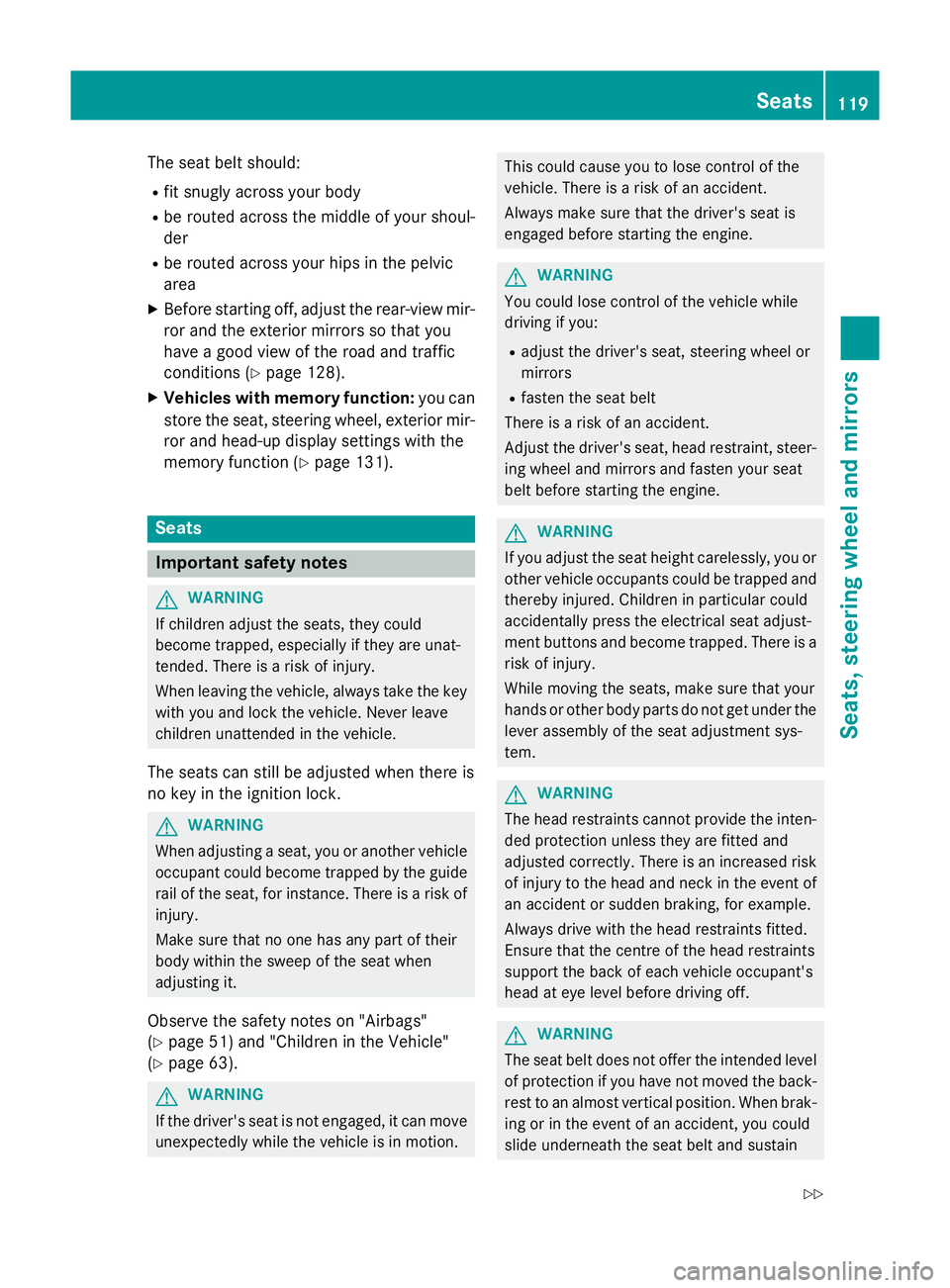
The seat belt should:
R fit snugly across your body
R be routed across the middle of your shoul-
der
R be routed across your hips in the pelvic
area
X Before starting off, adjust the rear-view mir-
ror and the exterior mirrors so that you
have a good view of the road and traffic
conditions (Y page 128).
X Vehicles with memory function: you can
store the seat, steering wheel, exterior mir-
ror and head-up display settings with the
memory function (Y page 131). Seats
Important safety notes
G
WARNING
If children adjust the seats, they could
become trapped, especially if they are unat-
tended. There is a risk of injury.
When leaving the vehicle, always take the key with you and lock the vehicle. Never leave
children unattended in the vehicle.
The seats can still be adjusted when there is
no key in the ignition lock. G
WARNING
When adjusting a seat, you or another vehicle occupant could become trapped by the guiderail of the seat, for instance. There is a risk of
injury.
Make sure that no one has any part of their
body within the sweep of the seat when
adjusting it.
Observe the safety notes on "Airbags"
(Y page 51) and "Children in the Vehicle"
(Y page 63). G
WARNING
If the driver's seat is not engaged, it can move unexpectedly while the vehicle is in motion. This could cause you to lose control of the
vehicle. There is a risk of an accident.
Always make sure that the driver's seat is
engaged before starting the engine.
G
WARNING
You could lose control of the vehicle while
driving if you:
R adjust the driver's seat, steering wheel or
mirrors
R fasten the seat belt
There is a risk of an accident.
Adjust the driver's seat, head restraint, steer-
ing wheel and mirrors and fasten your seat
belt before starting the engine. G
WARNING
If you adjust the seat height carelessly, you or other vehicle occupants could be trapped andthereby injured. Children in particular could
accidentally press the electrical seat adjust-
ment buttons and become trapped. There is a
risk of injury.
While moving the seats, make sure that your
hands or other body parts do not get under the
lever assembly of the seat adjustment sys-
tem. G
WARNING
The head restraints cannot provide the inten-
ded protection unless they are fitted and
adjusted correctly. There is an increased risk of injury to the head and neck in the event of
an accident or sudden braking, for example.
Always drive with the head restraints fitted.
Ensure that the centre of the head restraints
support the back of each vehicle occupant's
head at eye level before driving off. G
WARNING
The seat belt does not offer the intended level of protection if you have not moved the back-
rest to an almost vertical position. When brak-
ing or in the event of an accident, you could
slide underneath the seat belt and sustain Seats
119Seats, steering wheel and mirrors
Z